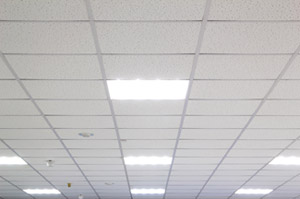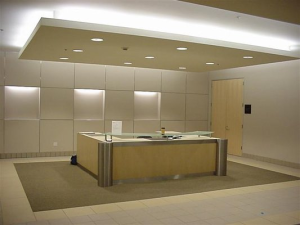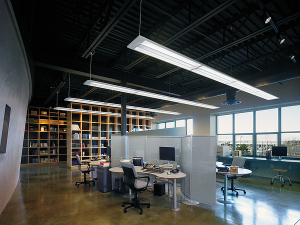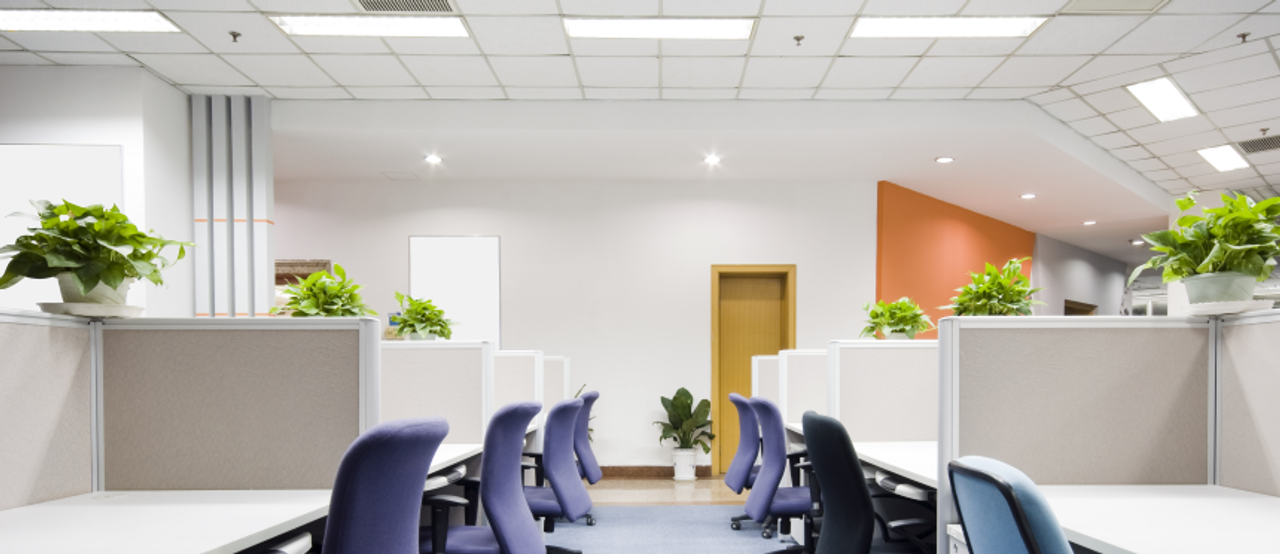Options for Office Lighting Fixtures
Choosing the right office lighting fixtures for your lighting project doesn't have to be a chore. With a little planning and basic research, you can improve the lighting in your office and reduce your operating costs in one fell swoop. The type of fixtures that you can choose from will mainly depend on the type of ceiling in your office space. We’ll discuss the different options for the most popular commercial ceiling types and provide links to recommended fixtures. As always, if you need any help, please feel free to contact one of our lighting experts at (888) 548-6387 or send us an email.
 The vast majority of commercial office space in the US has what is commonly called a dropped ceiling, but there are many other names this is known by:
The vast majority of commercial office space in the US has what is commonly called a dropped ceiling, but there are many other names this is known by:
 RelightDepot offers surface mount versions of many popular recessed fixtures. This includes the surface-mounted parabolic series and surface-mounted center basket direct/indirect troffers. These surface mount commercial fixtures provide the same light output as the recessed versions, but feature an attractive enclosure that can be surface-mounted to the drywall ceiling. If these options aren’t enough, the 1x4, 2x2 and 2x4 frame in kit can be used to mount any of the standard troffer fixtures into a drywall ceiling. Before using this option, however, care should be taken to make sure that there is enough clearance between the trusses above the ceiling to allow for the lights to be placed where desired.
While linear wrap fixtures are the least common lighting fixtures for drop ceiling applications, they’re a very popular choice for small offices with drywall ceilings. The linear wrap fixture, or wraparound fixture, is composed of the fixture body that houses the lamps and ballasts, and the lens, which typically wraps around the fixture body. These are available in traditional prismatic acrylic and many variations of matte white puff or cloud models. The wrap or puff fixtures provide good light distribution and are easy to install onto the ceiling directly below a junction box.
[product ids="835,886,979,966"]
Just as in offices with drop ceiling, recessed can lighting can be used as either the main lighting source, or as a supplement to a primary lighting system. Recessed cans are available in a variety of sizes and shapes and the trim can be selected to compliment the finish of the space. Designers also use cove lighting to accentuate differences in the space and provide an interesting aesthetic to an otherwise large flat ceiling.cove lighting to accentuate differences in the space and provide an interesting aesthetic to an otherwise large flat ceiling.
RelightDepot offers surface mount versions of many popular recessed fixtures. This includes the surface-mounted parabolic series and surface-mounted center basket direct/indirect troffers. These surface mount commercial fixtures provide the same light output as the recessed versions, but feature an attractive enclosure that can be surface-mounted to the drywall ceiling. If these options aren’t enough, the 1x4, 2x2 and 2x4 frame in kit can be used to mount any of the standard troffer fixtures into a drywall ceiling. Before using this option, however, care should be taken to make sure that there is enough clearance between the trusses above the ceiling to allow for the lights to be placed where desired.
While linear wrap fixtures are the least common lighting fixtures for drop ceiling applications, they’re a very popular choice for small offices with drywall ceilings. The linear wrap fixture, or wraparound fixture, is composed of the fixture body that houses the lamps and ballasts, and the lens, which typically wraps around the fixture body. These are available in traditional prismatic acrylic and many variations of matte white puff or cloud models. The wrap or puff fixtures provide good light distribution and are easy to install onto the ceiling directly below a junction box.
[product ids="835,886,979,966"]
Just as in offices with drop ceiling, recessed can lighting can be used as either the main lighting source, or as a supplement to a primary lighting system. Recessed cans are available in a variety of sizes and shapes and the trim can be selected to compliment the finish of the space. Designers also use cove lighting to accentuate differences in the space and provide an interesting aesthetic to an otherwise large flat ceiling.cove lighting to accentuate differences in the space and provide an interesting aesthetic to an otherwise large flat ceiling.
 Due to the exposed nature of open ceiling plans, the only viable option for lighting these types of spaces is either with suspended fixtures hanging from the ceiling structure or surface mounted fixtures affixed to girders or other beams.
There are many options for pendant mounted linear fixtures as we discussed above, and this type of space really lends itself well to these types of fixtures. If using indirect pendant fixtures, those that shine light up towards the ceiling and use the reflection on the ceiling to light the space below, care should be taken to select a ceiling color that will let the light bounce back down towards the work surface. The lighter the color, the more light will reflect. If a light color is not ideal, the use of reflective panels or "floating" surfaces can improve light distribution and add a dramatic effect. Another option is to use a fixture with a reflective hood that provides indirect light but does not rely on the ceiling to reflect that light.
As the ceiling height increases, the demands on the lighting system also increase. Modern "loft" architecture can have soaring ceilings requiring the light to shine down from 20' or more. For these types of spaces, high bay style fixtures may be more appropriate. There are many high bay fixtures that provide an industrial look for the office space, but are built using more efficient fluorescent or LED technology.
[product ids="740,680,754,630"]
Due to the exposed nature of open ceiling plans, the only viable option for lighting these types of spaces is either with suspended fixtures hanging from the ceiling structure or surface mounted fixtures affixed to girders or other beams.
There are many options for pendant mounted linear fixtures as we discussed above, and this type of space really lends itself well to these types of fixtures. If using indirect pendant fixtures, those that shine light up towards the ceiling and use the reflection on the ceiling to light the space below, care should be taken to select a ceiling color that will let the light bounce back down towards the work surface. The lighter the color, the more light will reflect. If a light color is not ideal, the use of reflective panels or "floating" surfaces can improve light distribution and add a dramatic effect. Another option is to use a fixture with a reflective hood that provides indirect light but does not rely on the ceiling to reflect that light.
As the ceiling height increases, the demands on the lighting system also increase. Modern "loft" architecture can have soaring ceilings requiring the light to shine down from 20' or more. For these types of spaces, high bay style fixtures may be more appropriate. There are many high bay fixtures that provide an industrial look for the office space, but are built using more efficient fluorescent or LED technology.
[product ids="740,680,754,630"]
Office Lighting Fixtures by Ceiling Type
Since commercial office light fixtures are typically installed either in or on the ceiling, the type of ceiling construction in the office has a big impact on the types of fixtures that can be used. The most common ceiling types are “drop ceilings” (those that have acoustic tiles in an inverted T grid) and plaster or drywall ceilings. Many newer offices are being built with an open ceiling that exposes all of the mechanical components such as air conditioning duct work and steel trusses.- Drop Ceiling Lighting – these ceilings are actually a secondary ceiling made up of a metal grid hung from the main structural ceiling that holds acoustic panels in a uniform layout. Lighting in drop ceilings is either recessed into the grid, mounted on the panels, or suspended below the panels. Read more about drop ceiling lighting…
- Drywall Ceiling Lighting – this is a typical hard ceiling that can be made of a number of different materials. Lighting for plaster ceilings can be surface mounted or suspended from the ceiling. Recessing fixtures in this type of ceiling is typically more difficult due to limited access, but is very much doable. Read more about drywall ceiling lighting…
- Lighting for Open Ceilings – Open ceilings typically don’t have a smooth surface where lighting can be mounted to, nor can you recess fixtures into it because you would be piercing the floor above. The best lighting for open ceilings is pendant mounted fixtures that suspend below the structure of the ceiling and can provide either direct, indirect, or both direct and indirect lighting. Read more about open ceiling lighting…
Office Lighting Fixtures for Drop Ceilings
 The vast majority of commercial office space in the US has what is commonly called a dropped ceiling, but there are many other names this is known by:
The vast majority of commercial office space in the US has what is commonly called a dropped ceiling, but there are many other names this is known by:
- Drop ceiling
- Acoustic tile ceiling
- T-bar ceiling
- Inverted T-Grid ceiling
- Suspended ceiling
Office Lighting Fixtures for Drywall Ceilings
 RelightDepot offers surface mount versions of many popular recessed fixtures. This includes the surface-mounted parabolic series and surface-mounted center basket direct/indirect troffers. These surface mount commercial fixtures provide the same light output as the recessed versions, but feature an attractive enclosure that can be surface-mounted to the drywall ceiling. If these options aren’t enough, the 1x4, 2x2 and 2x4 frame in kit can be used to mount any of the standard troffer fixtures into a drywall ceiling. Before using this option, however, care should be taken to make sure that there is enough clearance between the trusses above the ceiling to allow for the lights to be placed where desired.
While linear wrap fixtures are the least common lighting fixtures for drop ceiling applications, they’re a very popular choice for small offices with drywall ceilings. The linear wrap fixture, or wraparound fixture, is composed of the fixture body that houses the lamps and ballasts, and the lens, which typically wraps around the fixture body. These are available in traditional prismatic acrylic and many variations of matte white puff or cloud models. The wrap or puff fixtures provide good light distribution and are easy to install onto the ceiling directly below a junction box.
[product ids="835,886,979,966"]
Just as in offices with drop ceiling, recessed can lighting can be used as either the main lighting source, or as a supplement to a primary lighting system. Recessed cans are available in a variety of sizes and shapes and the trim can be selected to compliment the finish of the space. Designers also use cove lighting to accentuate differences in the space and provide an interesting aesthetic to an otherwise large flat ceiling.cove lighting to accentuate differences in the space and provide an interesting aesthetic to an otherwise large flat ceiling.
RelightDepot offers surface mount versions of many popular recessed fixtures. This includes the surface-mounted parabolic series and surface-mounted center basket direct/indirect troffers. These surface mount commercial fixtures provide the same light output as the recessed versions, but feature an attractive enclosure that can be surface-mounted to the drywall ceiling. If these options aren’t enough, the 1x4, 2x2 and 2x4 frame in kit can be used to mount any of the standard troffer fixtures into a drywall ceiling. Before using this option, however, care should be taken to make sure that there is enough clearance between the trusses above the ceiling to allow for the lights to be placed where desired.
While linear wrap fixtures are the least common lighting fixtures for drop ceiling applications, they’re a very popular choice for small offices with drywall ceilings. The linear wrap fixture, or wraparound fixture, is composed of the fixture body that houses the lamps and ballasts, and the lens, which typically wraps around the fixture body. These are available in traditional prismatic acrylic and many variations of matte white puff or cloud models. The wrap or puff fixtures provide good light distribution and are easy to install onto the ceiling directly below a junction box.
[product ids="835,886,979,966"]
Just as in offices with drop ceiling, recessed can lighting can be used as either the main lighting source, or as a supplement to a primary lighting system. Recessed cans are available in a variety of sizes and shapes and the trim can be selected to compliment the finish of the space. Designers also use cove lighting to accentuate differences in the space and provide an interesting aesthetic to an otherwise large flat ceiling.cove lighting to accentuate differences in the space and provide an interesting aesthetic to an otherwise large flat ceiling.
Open Ceiling Office Lighting Fixtures
 Due to the exposed nature of open ceiling plans, the only viable option for lighting these types of spaces is either with suspended fixtures hanging from the ceiling structure or surface mounted fixtures affixed to girders or other beams.
There are many options for pendant mounted linear fixtures as we discussed above, and this type of space really lends itself well to these types of fixtures. If using indirect pendant fixtures, those that shine light up towards the ceiling and use the reflection on the ceiling to light the space below, care should be taken to select a ceiling color that will let the light bounce back down towards the work surface. The lighter the color, the more light will reflect. If a light color is not ideal, the use of reflective panels or "floating" surfaces can improve light distribution and add a dramatic effect. Another option is to use a fixture with a reflective hood that provides indirect light but does not rely on the ceiling to reflect that light.
As the ceiling height increases, the demands on the lighting system also increase. Modern "loft" architecture can have soaring ceilings requiring the light to shine down from 20' or more. For these types of spaces, high bay style fixtures may be more appropriate. There are many high bay fixtures that provide an industrial look for the office space, but are built using more efficient fluorescent or LED technology.
[product ids="740,680,754,630"]
Due to the exposed nature of open ceiling plans, the only viable option for lighting these types of spaces is either with suspended fixtures hanging from the ceiling structure or surface mounted fixtures affixed to girders or other beams.
There are many options for pendant mounted linear fixtures as we discussed above, and this type of space really lends itself well to these types of fixtures. If using indirect pendant fixtures, those that shine light up towards the ceiling and use the reflection on the ceiling to light the space below, care should be taken to select a ceiling color that will let the light bounce back down towards the work surface. The lighter the color, the more light will reflect. If a light color is not ideal, the use of reflective panels or "floating" surfaces can improve light distribution and add a dramatic effect. Another option is to use a fixture with a reflective hood that provides indirect light but does not rely on the ceiling to reflect that light.
As the ceiling height increases, the demands on the lighting system also increase. Modern "loft" architecture can have soaring ceilings requiring the light to shine down from 20' or more. For these types of spaces, high bay style fixtures may be more appropriate. There are many high bay fixtures that provide an industrial look for the office space, but are built using more efficient fluorescent or LED technology.
[product ids="740,680,754,630"]
Office Lighting Fixtures: Evaluation and Calculation
Like any lighting project, care should be taken to ensure that the right amount of light is provided for the task that is performed in the space. In the past, the standard practice was to provide uniform lighting throughout the office space. This has evolved with changes in how we work and the increased use of monitors in the workplace which has left many office spaces with more light than is needed. The current recommendation is to provide sufficient ambient light coupled with task lighting. Advanced controls such as daylighting can now be used to adjust the light levels within the office depending on the amount of light that is available through windows while the task lighting provides a more consistent light level on the work surface. Many municipalities are adopting more strict energy codes that require the use of advanced occupancy sensors or daylight controlled dimming. In the long run, this will lower energy bills, but the added cost is something to consider when you’re planning a lighting upgrade. The number of fixtures needed to light a space is highly dependent on the fixture type, the mounting height and the finishes in the room. As a rule of thumb, general office lighting can be achieved with one fixture every 8’ or so in a drop ceiling office. For linear pendant light fixtures, where the fixtures are typically installed in continuous rows, its more about selecting the right light source and configuration based on where the lights will be installed to reach the target light levels.RelightDepot Can Help
As you can see, there are lots of options for office lighting fixtures. Whether you’re thinking of retrofitting the existing fixtures or looking for brand new fixtures, RelightDepot can help. If you're still unsure about which light fixtures you should choose for your office lighting project, feel free to contact us today to discuss your specific needs. We have a wide variety of energy-efficient light fixtures to best serve offices and commercial buildings, and our lighting experts can help you through every step of the process.May 30, 2014







